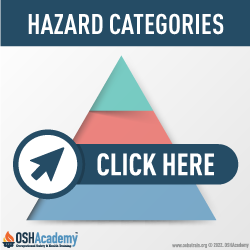Step 1: Identifying Hazards
The goal of this step is to identify hazards that could cause harm to people, property, or the environment.
To help identify hazards, we can group them into three categories: physical hazards, behavioral hazards, and systemic hazards.
Physical hazards. This first category includes: materials, tools, equipment, machinery, and the physical environment.
Each of these represent unique hazardous physical conditions. It may seem counterintuitive, but physical hazards actually account for the fewest number of workplace accidents.
- Materials. Hazardous materials include hazardous:
- Liquid and solid chemicals such as acids, bases, solvents, explosives, etc.
- Solids like metal, wood, and plastics.
- Gases like hydrogen sulfide, methane, etc.
- Equipment. This area includes machinery and tools used to produce or process goods. These examples all represent hazardous conditions in the workplace. Examples include:
- Equipment may not be properly guarded or maintained.
- Tools may be defective or not used for the intended purpose.
- Environment. This area includes facility design, hazardous atmospheres, temperature, noise, factors that cause stress and contribute to an unsafe environment. Examples include:
- Areas in your workplace may be too hot, cold, dusty, dirty, messy, wet, etc.
- The facility may be too noisy, or contain dangerous gases, vapors, liquids, or fumes.
- Facility and workstation design may not be suitable for the worker.
- The workplace psychosocial climate may be causing stress, hurry, or illness.
Behavioral hazards. This second category describes unique unsafe employee behaviors and practices in the workplace. Unsafe behaviors and practices account for more workplace accidents.
- Personal actions and performance. This area includes unsafe employee behaviors at all levels in the organization. Examples include:
- Employees might take short cuts, not use personal protective equipment, or otherwise ignore safety rules.
- Employees improperly use tools, equipment, machinery, or vehicles.
- Supervisors might tell their employees to take shortcuts to ensure the work schedule is met.
- Managers might act in a coercive manner towards their supervisors
Systemic hazards. The last category includes weaknesses in the structure, design, and performance of the safety management system. These systemic weaknesses contribute to the unique hazardous physical conditions and unsafe personal behaviors. Ultimately, they are responsible for most injuries and illnesses in the workplace.
- System structure, design, and performance. To varying degrees, every company possesses a Safety and Health Management System (SHMS). Weaknesses within this system often represent the root causes that contribute to the majority of workplace accidents. Common examples of such weaknesses include:
- A safety manager, officer, or coordinator has not been hired.
- A functioning safety committee does not exist.
- Written preventive/corrective maintenance programs are not developed.
- Employees have not been trained on their safety responsibilities.
To remember the three hazard categories, just use the following acronym:
We'll discuss four important methods for identifying hazards: inspections, observations, Job Hazard Analyses (JHAs) and incident/accident investigations.
Knowledge Check Choose the best answer for the question.
5-3. Which of the three workplace hazard categories may ultimately be responsible for most, if not all, accidents in the workplace?
You forgot to answer the question!

